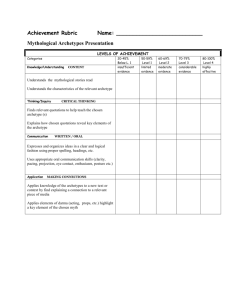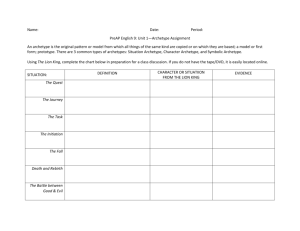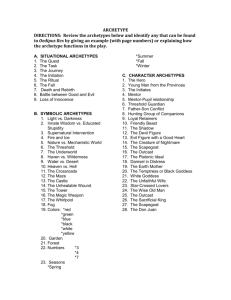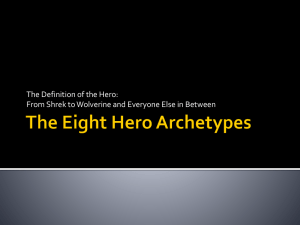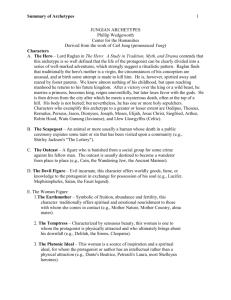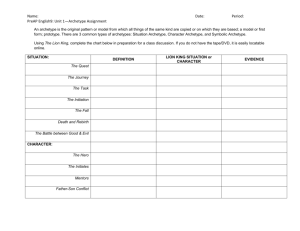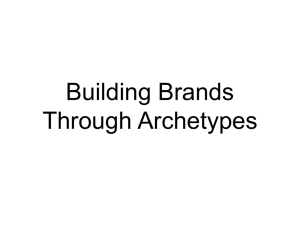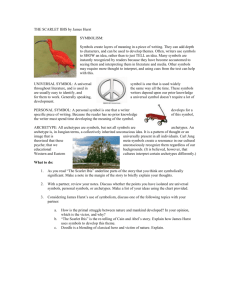Sign, Symbol and Archetype
advertisement
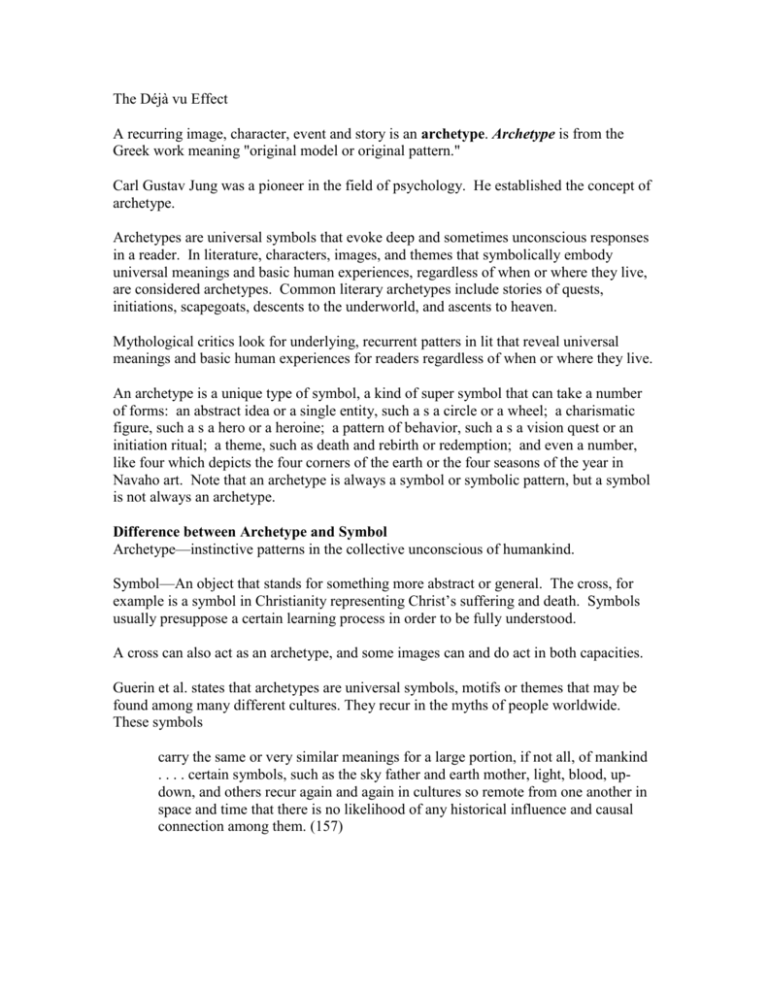
The Déjà vu Effect A recurring image, character, event and story is an archetype. Archetype is from the Greek work meaning "original model or original pattern." Carl Gustav Jung was a pioneer in the field of psychology. He established the concept of archetype. Archetypes are universal symbols that evoke deep and sometimes unconscious responses in a reader. In literature, characters, images, and themes that symbolically embody universal meanings and basic human experiences, regardless of when or where they live, are considered archetypes. Common literary archetypes include stories of quests, initiations, scapegoats, descents to the underworld, and ascents to heaven. Mythological critics look for underlying, recurrent patters in lit that reveal universal meanings and basic human experiences for readers regardless of when or where they live. An archetype is a unique type of symbol, a kind of super symbol that can take a number of forms: an abstract idea or a single entity, such a s a circle or a wheel; a charismatic figure, such a s a hero or a heroine; a pattern of behavior, such a s a vision quest or an initiation ritual; a theme, such as death and rebirth or redemption; and even a number, like four which depicts the four corners of the earth or the four seasons of the year in Navaho art. Note that an archetype is always a symbol or symbolic pattern, but a symbol is not always an archetype. Difference between Archetype and Symbol Archetype—instinctive patterns in the collective unconscious of humankind. Symbol—An object that stands for something more abstract or general. The cross, for example is a symbol in Christianity representing Christ’s suffering and death. Symbols usually presuppose a certain learning process in order to be fully understood. A cross can also act as an archetype, and some images can and do act in both capacities. Guerin et al. states that archetypes are universal symbols, motifs or themes that may be found among many different cultures. They recur in the myths of people worldwide. These symbols carry the same or very similar meanings for a large portion, if not all, of mankind . . . . certain symbols, such as the sky father and earth mother, light, blood, updown, and others recur again and again in cultures so remote from one another in space and time that there is no likelihood of any historical influence and causal connection among them. (157) Water: birth-death-resurrection; creation; purification and redemption; fertility and growth. Sea/ocean: the mother of all life; spiritual mystery; death and/or rebirth; timelessness and eternity. Rivers: death and rebirth (baptism); the flowing of time into eternity; transitional phases of the life cycle. . . . Sun (fire and sky are closely related): creative energy; thinking, enlightenment, wisdom, spiritual vision. Rising sun: birth, creation, enlightenment. Setting sun: death. Colors: Red: blood, sacrifice, passion; disorder. Green: growth, hope, fertility. Blue: highly positive; secure; tranquil; spiritual purity. Black: darkness, chaos, mystery, the unknown, death, wisdom, evil, melancholy. White: light, purity, innocence, timelessness; [negative: death, terror, supernatural] Yellow: enlightenment, wisdom. Serpent (snake, worm): symbol of energy and pure force (libido); evil, corruption, sensuality, destruction. Numbers: 3 - light, spiritual awareness, unity (the Holy Trinity); male principle. 4 - associated with the circle, life cycle, four seasons; female principle, earth, nature, elements. 7 - the most potent of all symbolic numbers signifying the union of three and four, the completion of a cycle, perfect order, perfect number; religious symbol. Wise old Man: savior, redeemer, guru, representing knowledge, reflection, insight, wisdom, intuition, and morality. Garden: paradise, innocence, unspoiled beauty. Tree: denotes life of the cosmos; growth; proliferation; symbol of immortality; phallic symbol. Desert: spiritual aridity; death; hopelessness. Creation: All cultures believe the Cosmos was brought into existence by some Supernatural Being (or Beings). Seasons: Spring - rebirth; genre/comedy. Summer - life; genre/romance. Fall - death/dying; genre/tragedy. Winter - without life/death; genre/irony. The great fish: divine creation/life. Freud's symbolism/archetypes: Concave images (ponds, flowers, cups, vases, hollows): female or womb symbols. Phallic symbols (towers, mountain peaks, snakes, knives, swords, etc.) male symbols. Dancing, riding, or flying: symbols of sexual pleasure. The hero, The antihero Initiation Death -Rebirth -Renewal The Benevolent Guide The Sacred Marriage the Trickster The mercenary The Scapegoat Orphan Martyr Wanderer Warrior Magician ARCHETYPE LESSON GUIDE Read Synopsis of Jung’s Archetypes pg. 5 Give a general list of archetypes Give Archetype Quiz Discuss in terms of Beloved Read Circle as Archetype How is the circle an archetype in Handout #3? See page 3 Does the circle carry any symbolic meaning or archetypal power in their own lives or belief systems? Read Mythology Packet & Discuss Watch Cambell’s Mother Goddess segment and take notes Lesson 4: Manifestations of the Mother Goddess Watch Campbell’s Hero video segment and take notes
